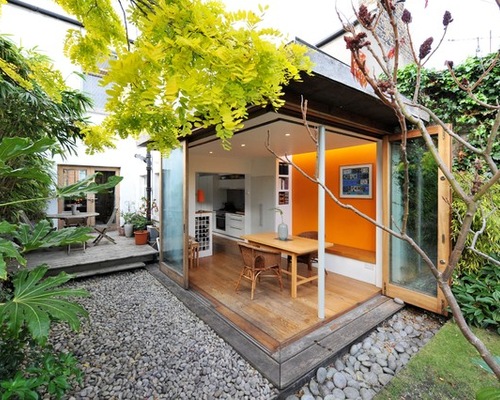31,198 Conservatory Design Photos
A conservatory, garden room or orangery is a decidedly British and Irish home extension: a room that allows us to enjoy our outdoor space without having to brave the unpredictable weather. Originally a type of glass house or greenhouse where plants could be grown in sheltered conditions, the modern conservatory now offers flexible entertainment space. Your conservatory can serve as an additional living area, a garden room, a spacious dining room or an open-plan kitchen; all flooded with the extra light that a glass extension will give you. More
What conservatory style should I choose?
A lean to conservatory is the most straight-forward garden room structure with a slanted roof that appears to lean on the original house wall. If you’re looking for a small conservatory then the simple rectangular design of lean to conservatories makes them ideal for bungalows and properties with small gardens.
The Victorian conservatory is the most common style, with an elegant shape which features a rounded end wall. An Edwardian conservatory is built similarly, but with a rectangular shape that is perhaps more space-efficient. L or P-shaped conservatories combine the styles of both Victorian and Edwardian garden rooms, and offer a versatile space that can be split into separate areas.
Contemporary garden rooms with large glass walls are fantastic additions to modern homes or extensions and can create stunning exteriors. However, designs like these do use a lot of space and could require special planning permission. If you don’t have space for a large, contemporary garden room and you aren’t a fan of the uPVC conservatory, orangeries or sunrooms may appeal more; the structure is sympathetically designed to appear consistent with the style of the house.
What is an orangery?
They are both glass-walled and -roofed structures, but what is the difference between a conservatory and an orangery? The traditional orangery has a longer history ‐ it became popular in the 17th Century when homeowners wanted a place to grow citrus plants (e.g. orange trees, hence ‘orangery’) and so built structures, either stand alone or incorporated into their homes, with glass walls and roofs, similar to greenhouses.
The conservatory is actually believed to have developed from the orangery after the fashion for growing citrus plants died down. However, homeowners still wanted a place to grow other tropical, herb or shrub plants that would allow sun and warmth into the house in summer and allow the plants to survive in winter.
Today, the real difference is in the construction. Orangeries are considered traditional extensions with masonry walls and more standard Victorian structures, whereas modern conservatories can be more varied and made of a range of materials, including timber, uPVC or aluminium.
What type of conservatory furniture do I need?
Chances are your conservatory furniture will see a high amount of direct sunlight. Keep this in mind when choosing pieces, since some fabrics and materials can quickly fade or become uncomfortably hot. Outdoor furniture will generally stand up well to the heat and light exposure of sunrooms and orangeries, but don’t be afraid to mix and match with indoor pieces as well. Wicker, seagrass and rattan furniture items are good options, while you might want to steer away from metal and leather pieces which will get hot in the sunlight. Installing conservatory blinds or shades that can be drawn when the room isn't in use is a smart way to prolong the life of your sunroom furniture when the space is not in use.
This website uses cookies. By continuing you agree to their use. Learn more








